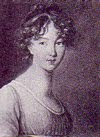
This is a very easy project from Exercises in Knitting (1846) by Mrs. Cornelia Mee and works up very quickly. The colours are meant to imitate five shades of sable or chinchilla fur. The original pattern calls for “double German wool” whose modern equivalent would be a double knitting or sport weight wool. I used Knit Picks’s Palette. I experimented with various sizes of needles and settled on 4mm/US 6 size needles to get the gauge/tension I needed to make a muff that measured 14" across. The knitting actually measures 15", that extra inch providing the half-inch seam on each underside. The pattern runs from light to dark and then back down through the dark colours to the lightest. Each set comprises a stripe and four stripes “are required.” The lining should be “satin put underneath the knitting of the same colour;” I used a silver imitation satin fabric, and all of the sewing was done by hand.

I hate blocking and did not block this piece, even though it was slanted, when finished. I was able to avoid this step as the knitting was to be sewn onto the satin. I first made a four layer lining with a cotton pillow or sack on the inside, filled with washed and carded merino fleece, and the “satin” on the outside. I basted all four layers together before sewing them and, in fact, basted the pillow every step of the way which, especially when the knitting was attached, helped to shape the stripes and straighten out the slant. The knitted piece was sewn on the satin pillow with the strands of carried wool folded under the interior seam. The pillow was then rolled and sewn along the long edge and the final step was to sew the two white knitted edges together.


I used the muff today in very, very cold weather and it was lovely and warm. There is no extra room on the inside so my hands, in lace mitts, were snug and cosy.








